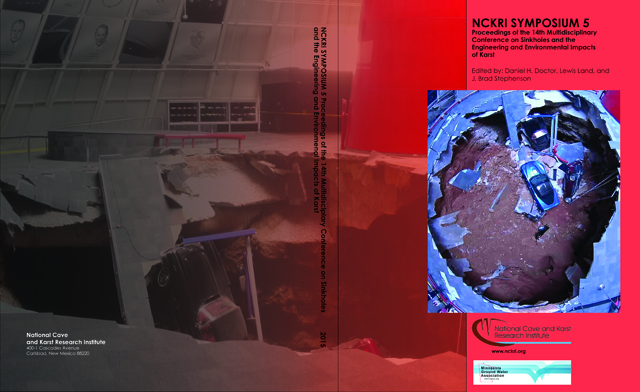Abstract
Presence of solution cavities of different sizes poses major engineering problems in some areas of Abu Dhabi City Municipality (ADM) underlain by soluble rocks such as gypsum, calcarenite, or mudstone. This is especially critical if they are located at a relatively shallow level and are likely to cause settlement or sudden soil collapse. The Gachsaran Formation, which is composed of interlayered mudstone and gypsum, underlies all of the ADM and is known to be vulnerable to cavity formation in the area. The mudstone and gypsum beds within the upper part of the Gachsaran Formation are prone to dissolution. Numerous sinkholes have been reported, particularly in the zone between Abu Dhabi International Airport and Mafraq. Many geotechnical and geological reports and surveys were reviewed for extracting information related to geological and hydrogeological conditions causing cavities in the ADM. Information associated with cavities was cataloged and reviewed based on available data from an existing geotechnical borehole database maintained by the ADM. Cavity data obtained from borehole information was analyzed to examine cavity distributions based on the following factors: lithology, geographic clusters, cavity density, cavity size, depth to cavity, and depth to bedrock. All cavities were grouped into geographic clusters and lithological clusters for point-pattern analysis. Most cavities (87 percent) occur in mudstone or gypsum, or at an interface between these two rock types, which compose part of the Gachsaran Formation. The dissolution of carbonate and evaporites within this formation causes the formation of subsurface voids in the ADM area. Geographically, majority of cavities occurred in the Shakhbout City area, hence pattern analysis including average nearest neighbor analysis, Moran’s I for measuring spatial autocorrelation, and G-statistics for measuring high/low clustering were conducted in this area using spatial statistics tools in ArcGIS. Average nearest neighbor analysis and Moran’s- I show that cavities are strongly clustered in this area with a high confidence level (>99 percent). General G-statistics identified a high clustering (hot spot) of cavities with relatively high values of depth to cavity, depth to bedrock, and number of cavities per borehole. No highly clustered large cavities were detected by the General G-statistics. Additionally, distances to the first through the 9th nearest neighbors were determined for cavities in different lithological materials and geographical clusters. Outcome of these spatial correlation and statistical analysis can be used to conduct risk assessment and the probability of occurrences of future cavities.
Rights Information
DOI
http://dx.doi.org/10.5038/9780991000951.1088
Evaluation of Cavity Distribution Using Point-Pattern Analysis
Presence of solution cavities of different sizes poses major engineering problems in some areas of Abu Dhabi City Municipality (ADM) underlain by soluble rocks such as gypsum, calcarenite, or mudstone. This is especially critical if they are located at a relatively shallow level and are likely to cause settlement or sudden soil collapse. The Gachsaran Formation, which is composed of interlayered mudstone and gypsum, underlies all of the ADM and is known to be vulnerable to cavity formation in the area. The mudstone and gypsum beds within the upper part of the Gachsaran Formation are prone to dissolution. Numerous sinkholes have been reported, particularly in the zone between Abu Dhabi International Airport and Mafraq. Many geotechnical and geological reports and surveys were reviewed for extracting information related to geological and hydrogeological conditions causing cavities in the ADM. Information associated with cavities was cataloged and reviewed based on available data from an existing geotechnical borehole database maintained by the ADM. Cavity data obtained from borehole information was analyzed to examine cavity distributions based on the following factors: lithology, geographic clusters, cavity density, cavity size, depth to cavity, and depth to bedrock. All cavities were grouped into geographic clusters and lithological clusters for point-pattern analysis. Most cavities (87 percent) occur in mudstone or gypsum, or at an interface between these two rock types, which compose part of the Gachsaran Formation. The dissolution of carbonate and evaporites within this formation causes the formation of subsurface voids in the ADM area. Geographically, majority of cavities occurred in the Shakhbout City area, hence pattern analysis including average nearest neighbor analysis, Moran’s I for measuring spatial autocorrelation, and G-statistics for measuring high/low clustering were conducted in this area using spatial statistics tools in ArcGIS. Average nearest neighbor analysis and Moran’s- I show that cavities are strongly clustered in this area with a high confidence level (>99 percent). General G-statistics identified a high clustering (hot spot) of cavities with relatively high values of depth to cavity, depth to bedrock, and number of cavities per borehole. No highly clustered large cavities were detected by the General G-statistics. Additionally, distances to the first through the 9th nearest neighbors were determined for cavities in different lithological materials and geographical clusters. Outcome of these spatial correlation and statistical analysis can be used to conduct risk assessment and the probability of occurrences of future cavities.


